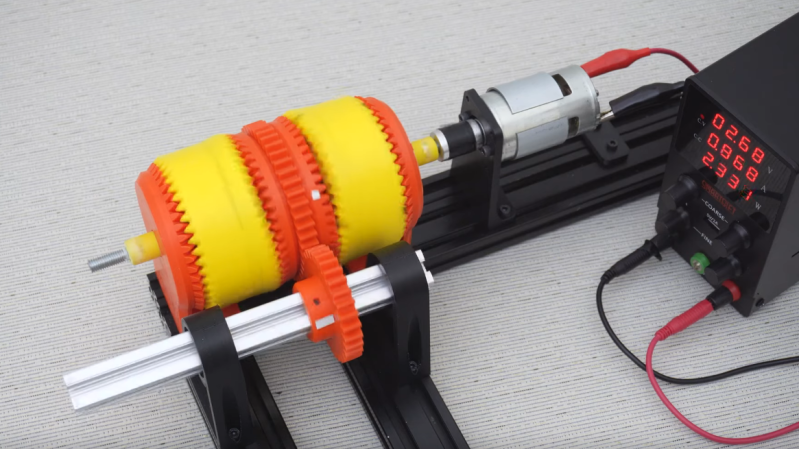With few exceptions, power transmission is a field where wobbling is a bad thing. We generally want everything running straight and true, with gears and wheels perfectly perpendicular to their shafts, with everything moving smoothly and evenly. That’s not always the case, though, as this pericyclic gearbox demonstrates.
Although most of the components in [Retsetman] model gearboxes seem familiar enough — it’s mostly just a collection of bevel gears, like you’d see inside a differential — it’s their arrangement that makes everything work. More specifically, it’s the shaft upon which the bevel gears ride, which has a section that is tilted relative to the axis of the shaft. It’s just a couple of degrees, but that small bit of inclination, called nutation, makes the ring gear riding on it wobble as the shaft rotates, allowing it to mesh with one or more ring gears that are perpendicular to the shaft. This engages a few teeth at a time, transferring torque from one gear to another. It’s easier to visualize than it is to explain, so check out the video below.
Gearboxes like these have a lot of interesting properties, with the main one being gear ratio. [Retsetman] achieved a 400:1 ratio with just 3D printed parts, which of course impose their own limitations. But he was still able to apply some pretty serious torque. The arrangement is not without its drawbacks, of course, with the wobbling bits naturally causing unwelcome vibrations. That can be mitigated to some degree using multiple rotatins elements that offset each other, but that only seems to reduce vibration, not eliminate it.
[Retsetman] is no stranger to interesting gearboxes, of course, with his toothless magnetic gearboxes coming to mind. And this isn’t the only time we’ve seen gearboxes go all wobbly, either.
Thanks to [Keith Olson] for the tip.















Looks like the same principal as Strain Wave Gearing in a different plane, I like it :-)
So what’s the benefit?
This potentially provides a compact gearbox with a with a low (e.g. 400:1) drive ratio that is hard to be back drive.
There was a similar gearbox called a strain wave (or harmonic drive), but these required the shape of the gear to deform which leads to a short life span (especially if 3D printed). This seems to have the advantages of the strain wave but without the need to deform any of the parts, which hopefully improves longevity.
I rather like a good old compound (stepped) planetary gear like this:
https://www.mathworks.com/help/sdl/ref/compoundplanetarygear.html
To get that high you need a lot of steps that are not compact or light at all.
-Very low gear ratios in small size
-Lots of teeth engaged at once instead of single point of failure
Although he mentions that a worm gear has about the same advantages while being far far simpler and cheaper
It would be interesting to see the efficiency compared with a worm gear, which is notoriously inefficient at higher ratios. Also good luck getting 400:1 in a worm gear that size. I would imagine complexity of manufacture and vibration are the two biggest drawbacks compared to a planetary unit.
There’s definitely room for improvement.
First of all, the pressure angle is most likely 20°, since this is the most common value. It’s linked to the force pushing the gearbox apart, so 14.5° or an even smaller value can be explored.
Next, unlike spur gears, the layer orientation most likely means the teeth will break off through layer separation. Another legitimate application for a 4- or 5-axis printer where the layers can be nested cylindrical shells.
Third, the nutating gear exerts a bending load on the shaft. The mechanical decreases with a smaller shaft, and it’s probably best to use a larger thin section bearing on the outside than small ones on the inside.
In the recent video* by [HowToMechatronics] there’s been a fair amount of destructive testing, which is all very interesting. Most of the attention seems to be wasted on technically inadequate show pieces such that they become the new norm. I’ve run into this repeatedly, be it with gears, ratchet and pawl mechanisms and even compliant mechanisms.
If anyone has a 5-axis 3D printer and can test conventional orientation vs. nested cylindrical layers, please do run some experiments and share the results!
* https://www.youtube.com/watch?v=EhzCQHOy3yw
*mechanical advantage
The real problem with it is that there are millions of excellent gearboxes already available, and everything else available is already configured for existing gearboxes which have been refined, tested, and well proven.
No further research is needed.
https://xkcd.com/2268/
>Most of the attention seems to be wasted on technically inadequate show pieces such that they become the new norm
Youtube views business model
“Gearzilla vs Mechagearzilla II”
I found something that seems to have lots of details about these pericyclic transmissions. https://www.geartechnology.com/ext/resources/issues/0321x/pericyclic-transmissions.pdf
I’d kind of like one of these tiny high-ratio reducer gearboxes as a way to use a drill instead of an impact for certain things that still require high torque but not hammering.